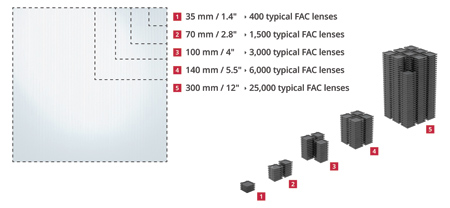
LIMO's capability to fabricate 300 mm glass wafers for the production of high-precision cylindrical lenses.

The edge length of the glass wafer, which can be simultaneously structured across its entire surface with the new technique, was increased from 35 mm (1.4") to up to 300 mm (12") in five steps. Since the wafer area scales quadratically with the edge length, with only a negligible increase in processing time, LIMO has been able to lower the production costs per sq. mm with each wafer generation.
"High-grade glass laser optics are now available for price-sensitive high-volume applications such as LIDAR and I.D. sensors due to a new production method," said a LIMO spokesperson. "LIMO GmbH, a maker of high-precision micro-optics for laser systems, can successfully process large 300 mm x 300 mm glass wafers and use the wafers to fabricate cost-effective micro-optics."
When mass-producing complex glass optics, manufacturers face the challenge of processing large wafer areas with a consistently high level of precision. "In 2018, LIMO achieved a technology breakthrough: It managed to produce 140 mm glass wafers for the fabrication of high-precision cylindrical lenses-without sacrificing any quality at all," said the spokesperson.
"After further enhancements to this technique, the company now has the capability of producing 300 mm glass wafers (12 inches x 12 inches)," continued the spokesperson. "The result: 25,000 FAC lenses with typical dimensions can be made from just one of these wafers, as well as other acylindrical lens arrays featuring consistently high optical quality. The advances in production technology have lowered the unit costs for high-grade diode laser optics made from glass to levels previously only seen for low-cost plastic lenses. For the first time ever, high-quality glass optics can also be used in price-sensitive consumer and high-volume applications."
Examples of typical application areas include:
- LIDAR for autonomous driving and autonomous transport (logistics, drones, etc.)
- Communications and data exchange, e.g., for smart computing and smartphones with optical I.D. sensors
- Defined homogeneous laser illumination for optical measurement
- Security (home automation, data sharing, financial transactions)
- Industry 4.0 applications (machine vision).
Advantages of glass optics:
- Glass optics provide enhanced functionality over a temperature range from -40 °C to at least +105 °C with long-term stability
- Glass optics offer consistent optical performance even when used with higher power outputs. Due to their zero hot-spot beam shaping, glass optics are also suitable for laser illumination in safety-related applications.
- "LIMO's manufacturing technique makes it possible to freely form surfaces along one axis, which allows the creation of any desired illumination area with an extremely wide angle (field of view of up to 120°)," said the spokesperson. This means that each sensor has a larger field of view-a benefit both in terms of the number of sensors required, e.g. in LIDAR systems, and for all types of consumer electronics in general.
High-quality, economical glass laser optics have potential for innovative applications, such as those used in additive manufacturing (3-D printing) and for LIDAR systems (laser-based light detection and ranging), suitable for high-volume demand.
For more information contact:
LIMO GmbH
info@limo.de
www.limo.de